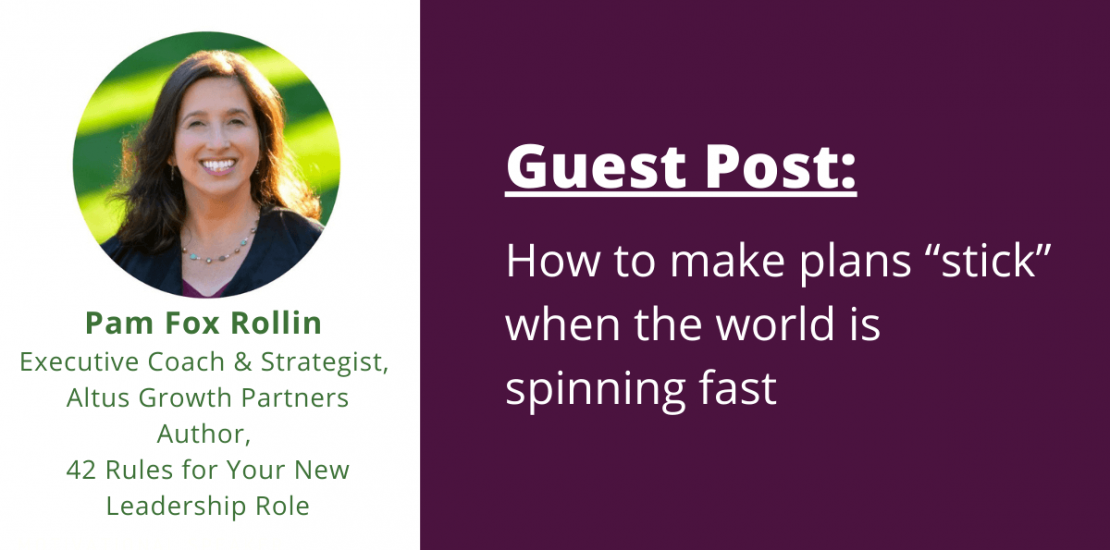How to Make Plans “Stick” When the World Is Spinning Fast
- January 27, 2021
- Posted by: Stage 4 Solutions
- Category: Blog

Guest Author: Pam Fox Rollin, Executive Coach & Strategist, Altus Growth Partners; Author, 42 Rules for Your New Leadership Role
Feel free to connect with your questions and thoughts: [email protected]
If you are running complex initiatives, your biggest challenge is usually aligning action across various teams to deliver results as planned. What can you do to make your plans more sticky? Drawing from her expertise as an Executive Coach and Strategist, Pam Fox Rollin lays out 5 tips on how to make plans “real.”
Act as if plans live in brains, not documents.
Because that’s the reality. Your plan just sits there on the share drive, while people do whatever they do. As Bob Dunham of Institute for Generative Leadership said, “The real plan is what is in the people’s heads as they leave the room” or, now, the Zoom.
If you prep so the kickoff is tight and smart, if you clearly explain the why and how of doing this project, connect the results to what they care about, ask for and work towards full commitment from your colleagues, dig for and handle their concerns, regularly review the plan with them, figure out what they need to implement and how to provide that, your project is on its way.
Embed the plan in all other systems.
You must make doing your plan easier than doing something else. So, ripple your plan through the systems: OKRs, Jira tickets, comp plans, functional meeting agendas, your senior team’s calendar, etc.
“But I don’t control any of those!” you say. Of course. So, go talk with each of the people who do. Describe the importance of this project to their goals, and ask them to bake specific alignments into their plan. If you hear No, ask what it would take to turn it into Yes. Half the time, you can see a way to pull this off that they haven’t seen yet. If you don’t ask, that’s zero percent of the time.
Hunt for what’s missing.
What’s missing to make implementation a success?
An agreement between two functions that tend to toss hot potatoes back and forth, rather than work together? OK, go help them decide who’s on point for what, at least for your project. Capacity? Have a real conversation with your exec sponsor about priorities and how to address this.
What I most often see as missing is a shared commitment to the success of the project. In no way does a head-nod to your plan replace real commitment. If you suspect commitment is lacking, go have those conversations.
What else is usually missing? Trust. Low trust that exec commitment will stick, trust that you’ll tell them immediately if this project has been deprioritized, trust that other departments will deliver their parts on time and to standard. You do your part by being fully trustworthy.
Capture the contingencies, then circle back on a cadence.
I’ve long been a fan of the Discovery-Driven Planning approach from Rita McGrath. In this approach, you identify and document the assumptions central to the plan, then go check regularly to see if the world has turned out as you expected.
For example, did product marketing actually fill the open position you’re counting on in the back half of the plan? It’s good to check on these things, so you can help them unblock or adjust your plan early enough to save delivery.
You stay steady.
You are at the center of success of your project, so be sure to do whatever keeps you calm and constructive: get enough sleep, eat healthy, go for a run, meditate, etc.
Ask yourself, what’s different in a meeting because you are here? Is there more clarity, more curiosity, more determination? Or is there more frustration, exhaustion, or blame?
When faced with competing demands on their time, people often support the projects that are better-run and frankly more fun or interesting. Be awesome to work with! Write short emails with accurate titles. Keep your Slack channels organized. Involve people who should be involved. Prep so your meetings are efficient, and you come in a good mood.
Your hard work now — getting the plan in people’s brains, coaching them through their concerns, documenting assumptions and circling back, showing up to every meeting at your best — will make the rest of the project more efficient. Worth your time? Experiment and see!
Pam Fox Rollin, Executive Coach & Strategist, Altus Growth Partners
Author, 42 Rules for Your New Leadership Role
Feel free to connect with your questions and thoughts: [email protected]

